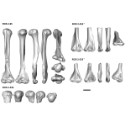Holotype of Hamadasuchus rebouli
Inner ear morphology in wild vs laboratory mice
3D models of the endocranial anatomy of Voay robustus and comparative specimens
3D GM dataset of bird skeletal variation
Skeletal embryonic development in the catshark
Bony connexions of the petrosal bone of extant hippos
bony labyrinth (11) , inner ear (10) , Eocene (8) , South America (8) , skull (7) , brain (6) , Oligocene (6)
Maëva Judith Orliac (17) , Lionel Hautier (17) , Bastien Mennecart (12) , Laurent Marivaux (11) , Pierre-Olivier Antoine (11) , Leonardo Kerber (10) , Renaud Lebrun (9)

|
3D models related to the publication: Systematic and locomotor diversification of the Adapis group (Primates, Adapiformes) in the late Eocene of the Quercy (Southwest France), revealed by humeral remains.Judit Marigó
Published online: 20/12/2018 |
|

|
M3#358Distal end of the left humerus ROS 2-534 attributed to the Adapis group Type: "3D_surfaces"doi: 10.18563/m3.sf.358 Data citation: Judit Marigó, Nicole Verrière and Marc Godinot, 2018. M3#358. doi: 10.18563/m3.sf.358 state:published |
Download 3D surface file |